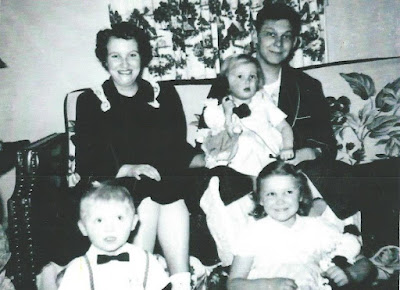Paul Jeckering – Christmas Day, 1953 – Dayton, Ohio
Snow had fallen through the night, layering the rooftops and sidewalks of Dayton in soft white silence. Inside the small two-bedroom house, the scent of cinnamon and coffee hung in the air, mingled with the sounds of young children waking to Christmas morning. Jean, five years old and full of holiday excitement, led the way down the hallway, whisper-shouting to her younger siblings. Mike, three, shuffled close behind, holding his sister’s hand, while little Karla — just two — toddled along, more fascinated by the shadows on the walls than by the idea of presents.
In the living room, the tree stood modestly decorated, its lights twinkling gently in the early light. Beneath it, a scattering of wrapped gifts waited patiently. The floor was soon alive with the rustle of paper and the delighted squeals of small voices. Dorothy moved quietly around the room, keeping a gentle pace as she watched her children — her hand resting now and then on her growing belly. Their fourth child was due in April.
But it was Paul everyone watched for.
At 28, he was far too young to be this sick. His kidneys were failing — a slow and brutal unraveling that had crept over the past year. Once strong, full of movement and life, Paul now spent most of his days in bed, his body thin and worn. But this morning, he’d insisted on coming downstairs, if only for a while. “Just long enough to see their faces,” he’d said softly.
It had taken effort, but with Dorothy’s help and quiet determination of his own, Paul made his way to the living room and sat on the couch beside her. He wore his bathrobe — flannel, faded, tied snugly at the waist — and smiled through the fatigue. His dark hair was combed neatly, his eyes tired but focused.
He had always been a man of quiet depth — a gifted sculptor, with hands that shaped clay and wood into expressive, delicate forms. Long before he fell ill, and even before the war, Paul had drawn and carved with a talent that surprised those who knew him only as a machinist at National Cash Register. After serving in the Pacific during World War II — a chapter of his life he rarely spoke of in detail — he returned home with an even deeper appreciation for beauty, for silence, for the things that endure. His art was never for praise or attention. It was how he processed the world. How he left a mark.
That morning, Dorothy gathered the family for a photograph. Paul shifted carefully, drawing Karla onto his lap, her curly head resting against his chest. Dorothy sat beside him, her hand gently tucked into his. Jean and Mike knelt on the floor in front of them, close together, Jean leaning toward her brother with a proud, protective air. The tree glowed behind them, and outside the window, snowflakes still fell.
Dorothy steadied the camera, clicked the shutter.
A moment captured — a father in his last Christmas, surrounded by his young family, holding them close despite the pain. The photo would later become a cherished memory, a reminder of presence, of love, of resilience in the face of fading time.
Later, Paul returned to bed, exhausted but grateful. From down the hall he could hear the children’s laughter and the crinkle of wrapping paper, Dorothy’s voice soft and steady as she read aloud to them. The house was filled with life, and though his body was failing, his spirit was not.
That night, as the world quieted once again, Paul looked toward the soft lights of the tree, still glowing faintly. He felt the warmth of Dorothy’s hand in his, the ache of his body, and the comforting weight of having been there — not just in the room, but truly present.
It was Christmas. And he was still an artist, still a husband, still a father.
Still here.
Please comment and share this post via Twitter, Facebook or any other social media platform. If you have any questions or personal comments, please reach out to Carriesmith11411@yahoo.com.
Copyright (c) 2025, Carrie Smith


No comments:
Post a Comment